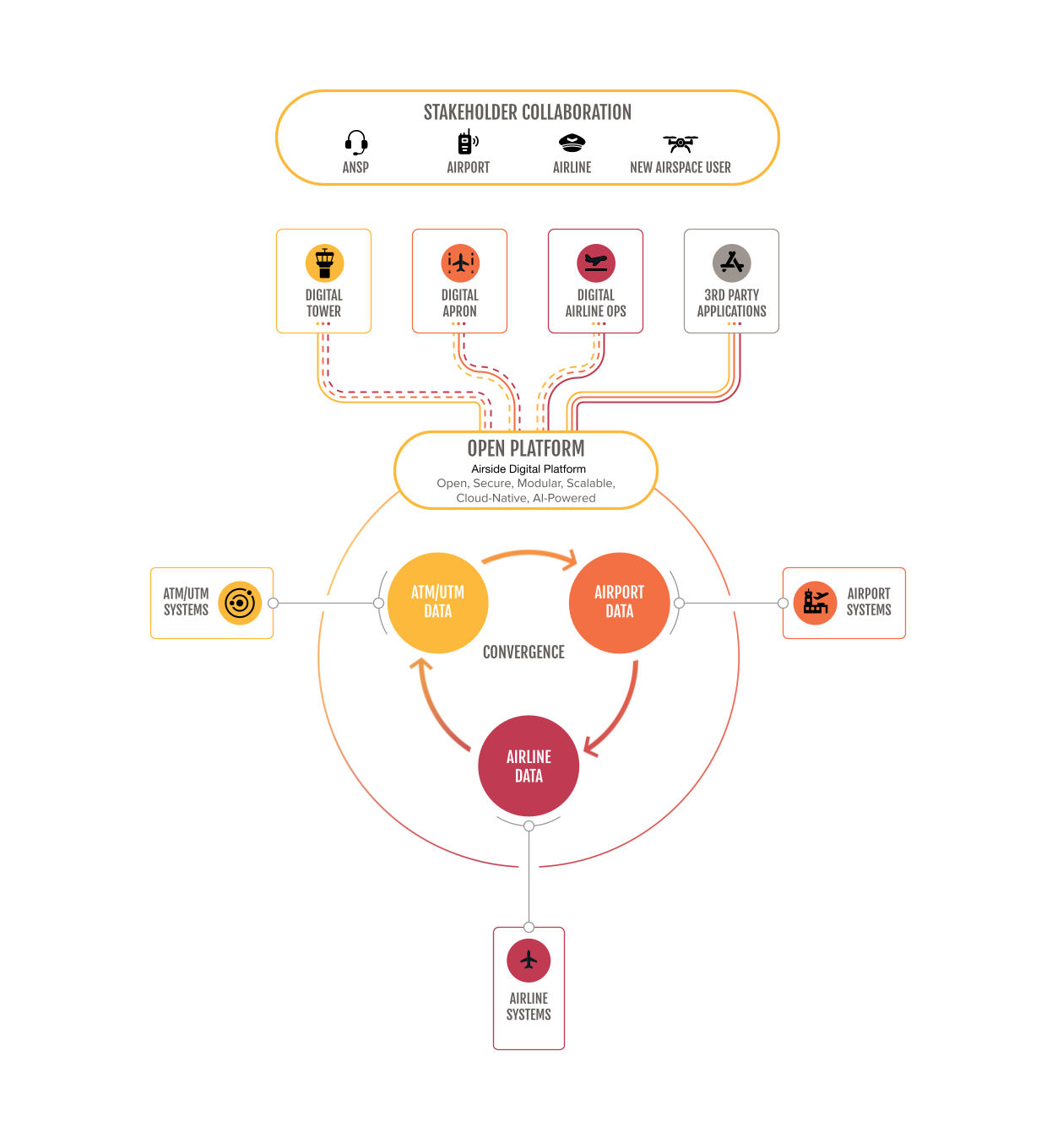Aviation is at a crossroads.
On one side is the familiarity of legacy systems, including decades-old air traffic control infrastructure and manual ground operations.
On the other is the promise of digital transformation: smarter flight management, real-time operational insights, and seamless passenger experiences driven by advanced technologies.
With many organizations caught in the middle relying on a mix of legacy systems and new technology.
You know you need to make changes. But how do you get started? What does your digital transformation journey involve?
Whether you’re an ANSP or working in airport operations, it can be challenging to know where to start with digital transformation. You need to make decisions about technology, vendors, partners, and where you want to be in 1, 3, 5, and 10 years.
We get it. This is a big ask. Particularly when you’re dealing with these common challenges to digital transformation:
- Resistance to change
- Legacy system integration
- Cybersecurity risks and data management
- System complexity due to siloed systems
- Fragmented stakeholder communication and collaboration
- Regulatory compliance
The hard truth about digital transformation is this–you haven’t done it before and it’s difficult to clearly understand the best path forward. You don’t know the questions to ask, what roadblocks to expect, or even how long this should take.
But this doesn’t mean you should do nothing.
Instead, you need to rethink your approach to digital transformation. You need to think about what is at the core of every decision, operation, and outcome—data.
Data is central to digital transformation. You need a solution that empowers smarter, more efficient, and confident decision-making, lowers TCO, and allows you to always be innovating.
Including your decisions around digital tower solutions, turnaround monitoring systems, stand planning partners, or virtual ramp technology–data and how you access, share, and manage this must be core to every technology and partner choice.
And this all starts with a platform.
What Is A Platform?
A platform is the digital foundation connecting systems, data, and stakeholders, enabling seamless collaboration and smarter decision-making.
A platform enables you to build an agile, flexible, and future-proofed technical solution that adapts seamlessly with your evolving needs and goals, ensuring quick and cost-effective scalability.
Across the aviation industry, a platform has the critical role in enabling digital transformation by breaking down operational and data silos and fostering collaboration between ANSPs, airports, and airlines.
By leveraging AI, machine learning, and data analytics, the platform drives digital transformation for all aviation stakeholders.

- ANSPs: A platform enables streamlined data exchange for predictive maintenance, demand forecasting, and operational optimization and the integration of advanced remote tower, digital apron, turnaround, and air traffic management software.
- Airports and Airlines: A platform optimizes operations by integrating real-time data from air traffic control, ground vehicles, and sensors, enhancing situational awareness, and minimizing delays.
It improves resource allocation by optimizing gate assignments, managing passenger flow, and streamlining turnaround times.
Additionally, it enables predictive maintenance for critical infrastructure, ensuring smoother operations and reducing disruptions.
A platform enables digital transformation in aviation, unifying data and systems to support smarter, more connected operations.
A platform reduces complexity, increases flexibility, and helps you stay competitive in a rapidly evolving industry.
How A Platform Enables Digital Transformation
Having a real-time view of airport operations at Hong Kong International Airport (HKIA) has transformed how the airport manages its complex airside environment—all made possible by its platform.
By integrating data from sources including optical sensors, radar systems, and flight information feeds, the platform provides real-time situational awareness to air traffic controllers and airport operations teams. This connectivity enables proactive decision-making, allowing staff to respond quickly to operational changes, minimizes delays, and optimizes the use of critical resources.
By driving smarter, data-driven processes through its platform, HKIA exemplifies how digital transformation can redefine airport management, ensuring safer, more efficient, and future-ready operations at one of the world’s busiest aviation hubs.
The decision you make about your platform has deep-reaching implications for your long-term success in this technology-driven industry.
Whether you work in airport operations or for an ANSP or airline, you need to understand the advantages of an open platform-based approach:
- Drives Digital Transformation: Speeds up the adoption of modern technologies, helping aviation operations run smarter, faster, and more efficiently.
- Secure Data Collaboration: Allows safe and reliable data sharing between key stakeholders, ensuring real-time visibility and communications.
- Enhanced System Safety: Sharing services across multiple stakeholders increases operational reliability, ensuring safer, more consistent performance.
- Vendor Flexibility: A modular and open design allows you to integrate and replace services from different providers, reducing dependency on a single vendor.
- Quicker, Cost-Effective Upgrades: System updates and changes happen faster and at a lower cost, minimizing disruptions to airport operations.
- Simplified Maintenance: Cleaner, more straightforward system design makes it easier to troubleshoot and maintain, enhancing overall reliability.
- Maximum Uptime: A highly available design ensures continuous operation, going beyond basic backup systems to keep essential services running smoothly.
- Future-Ready Expansion: Expanding or upgrading systems is seamless, enabling airports to scale as traffic grows or new technologies emerge.
EVERYTHING STARTS WITH A PLATFORM
The 6 Key Features to Look for in Your Platform
What are your pain points? Where are you in your digital transformation journey? What are your immediate and long-term goals?
This list of platform features is based on conversations with our customers about their digital transformation journey and where they want to be in 1, 3, 5, and 10 years.
- Scalability and Future-Readiness
Ensure the platform can scale your operations and adapt to future demands such as new airspace users, autonomous ground vehicles, and sustainability initiatives.
Can The Platform: manage a small number of UAM flights in designated corridors, then as demand increases, scale to handle higher traffic volumes, integrate with traditional air traffic control systems, and eventually support fully autonomous UAM operations? - Openness and Integration Capabilities
Look for open APIs and an open-source, scalable design that supports integration with third-party solutions, prevents vendor lock-in, and enables secure data sharing across all stakeholders.
Can The Platform: enable seamless integration of the airport’s existing systems, including flight information display systems, baggage handling, and gate management, and external systems from airlines, ground handlers, and air traffic controllers? - AI and Machine Learning
Look for a platform designed to support AI-driven tools, ensuring you get proactive responses and intelligence for predictive maintenance, operational optimization, anomaly detection, passenger needs and personalization, and demand forecasting.
Can The Platform: leverage technology to provide real-time recommendations to controllers by analyzing historical, live, and scheduled data for optimal resource allocation? - Cybersecurity and Data Protection
Ensure the platform is designed with cybersecurity and data protection at its core and does not rely on external third-party interfaces. Be confident there are zero risks to your data integrity or confidentiality once it’s in the platform.
Can The Platform: deliver on a security-first approach, ensuring all data is secured within a closed system, that allows for real-time data sharing with stakeholders while maintaining zero risk to your data integrity and confidentiality? - Modular Architecture
The platform must support efficient resource management, system resilience, simplified updates and rollbacks, scalability, and flexible deployment options. It’s time to move away from costly, resource-intensive monolithic legacy systems.
Can The Platform: enable the easy deployment of a new flight scheduling service without disrupting existing operations, allowing for seamless upgrades and rollbacks? For example, when a weather tracking module is updated, the rest of the system remains fully operational, ensuring continuous service while enhancing real-time weather monitoring capabilities. - On-Premise, Cloud, and Hybrid Deployment
Look for a platform that supports multiple deployment models, offering the flexibility to choose the best infrastructure for your current and future needs. Choose a platform that offers cloud, on-premise, and hybrid deployment models.
Can The Platform: enable you to deploy your flight management system on-premise while using cloud-based services for real-time passenger notifications?
We recommend prioritizing a platform that:
- Is flexible, open, and scalable to eliminate data and organizational silos
- Delivers the highest levels of ATC-grade safety and reliability
- Can grow with your future needs
Talk to us about Chorus—our industry-leading open platform
Comparing Your Aviation Platform Options
We understand that choosing a platform is not straightforward, particularly when the term platform is not used consistently.
This table gives you an easy way to quickly compare feature availability across the three primary platform types: Middleware-Only Platform, Proprietary Vendor-Specific Platform, and Open Platform.
| Capabilities | Middleware-Only Platform | Proprietary Platform (Vendor-Specific) | Open Platform (e.g. Chorus by Searidge) |
|---|---|---|---|
| Unified data management | ✔ | ✔ | ✔ |
| Unified application deployment, configuration and health monitoring | ✔ | ✔ | |
| Centralized cybersecurity | ✔ | ✔ | |
| ATC-grade assurance level (compliance with ED-109 and ED-153) | ✔ | ✔ | |
| Modern cloud-native technology stack | ✔ | ||
| Open to onboard 3rd-party applications | ✔ | ||
| Open APIs and message queue interfaces | ✔ | ||
| Industry-leading AI | ✔ | ||
| Out-of-the-box data integrations for ANSP, Airport and Airline systems | ✔ |
We want you to choose a partner with a proven track record, a commitment to technological growth, and a collaborative approach to solving your challenges. Do not hesitate to ask for references and success stories.
Our goal is ensuring that you make the right platform decision for your immediate and long-term goals.
Contact us to talk about your platform options and the features you need. We’re here to answer your questions.

6 Questions To Ask When Choosing Your Platform
When researching your platform options, make sure you ask these six questions:
- How will the platform reduce complexity and enable us to future-proof airside architecture to improve operational efficiency and safety of our ANSP or airport operations?
- Does the platform offer seamless integration with existing systems, including legacy infrastructure and future technologies like AI, IoT, and big data?
- How does the platform enhance collaboration and data sharing among various stakeholders to support A-CDM functionality?
- How does the platform address cybersecurity concerns and ensure compliance with aviation industry regulations and standards?
- Can the platform scale to accommodate multi-terminal or multi-airport operations as our organization grows?
- Will we be happy with this platform choice in 1, 3, 5, and 10 years?
Making The Right Platform Choice For Your Needs
We admit, Chorus is not the right choice for everyone—we want you to be confident you’re investing in the right technology and partner for your immediate and long-term needs.
We encourage you to take your time, ask questions, and do your due diligence.
Choose a partner with the people, processes, technology, expertise, and commitment to support both your strategic and immediate goals. This is a significant investment with long-term implications.
The last thing you want to do is get locked in with the wrong platform choice—as you know this has deep-reaching impacts for your digital transformation journey.
We’re here to answer your questions about how a platform enables digital transformation.
Let’s discuss your operational challenges and the best ways to address them.

